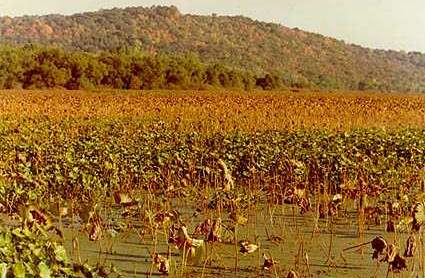
A mat of American lotus on a backwater lake.

A mat of American lotus on a backwater lake. |
Abandoned channels and sloughs left by the meandering Mississippi River often
developed into vegetation-choked wetlands. Aquatic herbaceous plants like the
American lotus (Nelumbo lutea), a historically-documented food for
Native Americans (ECON), created a lush summer cover on many shallow lakes.
Other water-tolerant plants found in and around these bottomland lakes,
marshes, and slow-moving streams include arrowhead, cattail, and wild sweet
potato.
|
| At slightly higher elevations -- on sand ridges and point bars, for example, where floodwaters drain more readily -- water-tolerant herbaceous pioneer plants, such as goosefoot, thrive. In some places, water-tolerant grasses, forbs, legumes, and sedges created expansive wetland prairies. These prairies were broken up into different sized patches by the bottomland forests near the river, its tributaries, creeks, and sloughs. |